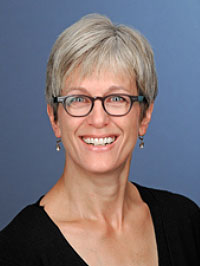How can school and agency personnel work together to support smooth transitions for these students?
Page 5: Establishing Interagency Collaboration
 Interagency collaboration does not happen overnight. It takes time for school personnel to develop a positive constructive working relationship with representatives from those outside agencies who provide services for students and families. There are multiple stages involved in establishing interagency collaboration.
Interagency collaboration does not happen overnight. It takes time for school personnel to develop a positive constructive working relationship with representatives from those outside agencies who provide services for students and families. There are multiple stages involved in establishing interagency collaboration.
| Stage | Definition | Example |
| Networking | The transition coordinator:
|
A transition coordinator shares information about local vocational rehabilitation (VR) services with a student and his family. |
| Coordination | The transition coordinator:
|
After meeting with a student and his family, the transition coordinator arranges a meeting with the VR representative for their school to discuss the student’s future goals towards employment. |
| Cooperation | The school and agency personnel:
|
The transition coordinator works with the VR representative for the school to share the workload related to students preparing for their post-school goals. The transition coordinator helps the students work on their transition portfolios while the VR representative conducts the pre-vocational assessments and interest inventories with students. |
| Collaboration | Teams composed of school personnel and representatives from community agencies:
|
The state education agency and the state VR agency develop a program that allows shared funding for transition services. As a result, several VR personnel are housed locally in the high schools to provide direct transition services. |
 At any given time, schools and agencies can be in various stages of interagency collaboration based on the needs of the students and the capacity of the community. They might be in a networking stage with one agency while having a stronger cooperative working relationship with another. Factors such as funding and staff supports, especially when shared, serve to strengthen collaborative efforts. Jointly funded programs or those in which staff work across agencies epitomize true interagency collaboration. These programs and services require teams to move beyond relationship-building and resource-sharing to work together to create new opportunities for youth with disabilities. Regardless of the type of working relationship they have, it is important that school representatives have a process in place for communicating with agency representatives, especially those that may be supporting the student or paying for post-school services.
At any given time, schools and agencies can be in various stages of interagency collaboration based on the needs of the students and the capacity of the community. They might be in a networking stage with one agency while having a stronger cooperative working relationship with another. Factors such as funding and staff supports, especially when shared, serve to strengthen collaborative efforts. Jointly funded programs or those in which staff work across agencies epitomize true interagency collaboration. These programs and services require teams to move beyond relationship-building and resource-sharing to work together to create new opportunities for youth with disabilities. Regardless of the type of working relationship they have, it is important that school representatives have a process in place for communicating with agency representatives, especially those that may be supporting the student or paying for post-school services.
Listen as Mary Morningstar talks about the stages of interagency collaboration in greater detail and provides examples (time: 5:38).

Mary Morningstar, PhD
Associate Professor Special Education
Director of Transition Coalition
University of Kansas
Transcript: Mary Morningstar, PhD
The stages of interagency collaboration are different. These first two—networking and coordination—are often the strategies that are more focused on what individual youth and families might need, versus the other two, cooperation and collaboration, which tend to be more systems or programmatic focused. I can give you examples that might allow for a better understanding at each of those four stages. In some respects, they’re sequential. So the first stage is networking. This is the lowest level. You can’t jump to full-scale collaboration until everyone who’s engaged has some understanding of what each other does to begin with. So oftentimes it’s the first stage when people come together to plan for and prepare during transition. So it is where, from a school perspective, they often spend time identifying the services that students and families need, and then sharing referral information. For example, a lot of districts develop transition guidebooks that include the range of community agencies in their community that families and students could access. Another example is a transition fair. Lots of schools, once or twice a year, bring together all the major agencies in their community, and they hold a transition fair where families and students can find out and talk with the range of community organizations based on what their needs are. Another example would be community resource mapping. This may be something that not just schools would do but they might do it with some other community organizations.
Within coordination, an example might be that a transition coordinator in a district would get a group of students together who are interested in going onto a community college in their town or in the town next door. They might go on a formal visit. They would be not only getting a visit of the campus but going and speaking directly with the disability student services organization at that community college. Students can ask questions about the accommodations they may need in order to be successful at that community college. It’s one step up from just knowing about what’s out there. It’s actually where school personnel and outside agencies can provide some more advocacy and support to the individual families and students to ensure there’s a successful handoff.
For cooperation and collaboration, this is where we start heading into more of a systems level. Some examples of that might be where a school, the district would invite VR counselors to come once a week and visit the school, maybe give them space where there is an office where VR counselors can actually do the intake process for vocational rehabilitation. Going back, schools might give referral information to families and students at the networking level then ratchet it up to a cooperation level. There might be a memorandum of understanding where VR comes into the school once a week and would complete some of the vocational assessment and intake process, so that students can be actually done with the referral process before they graduate from high school. That’s one example of how you might work at a systems level to cooperate together both from schools and outside agencies.
The schools may work with a mental health center for students who have been identified with mental health needs. They may be coordinating their counseling services and their mental health services with the school. A school social worker might be more involved so that students can access the adult mental health services that they need once they exit school. Those are examples of cooperation.
When we really talk about collaboration, it is where systems are developing new programs and probably where the rubber meets the road if they’re jointly funded. Up until now, you can do a lot together. The best example I know of—and it’s happening in many states—is where education funds and vocational rehabilitation funds jointly pool their resources and their funding so that they can provide substantial and intensive transition program particularly related to employment. The collaborative fundings allow new staff to be hired. They may be school staff that are partially funded with rehab money, or they may be a VR staff with partially funded money from schools. And those programs are the ones that are the most impactful in terms of the outcome for the students they’re serving with disabilities, and in this case in particular to employment.
For Your Information
One checklist commonly used by educational personnel to establish high-quality interagency collaboration is the Characteristics of Interagency Collaboration Assessment.